fuel cap AUDI S7 2013 Owners Manual
[x] Cancel search | Manufacturer: AUDI, Model Year: 2013, Model line: S7, Model: AUDI S7 2013Pages: 310, PDF Size: 77.45 MB
Page 14 of 310
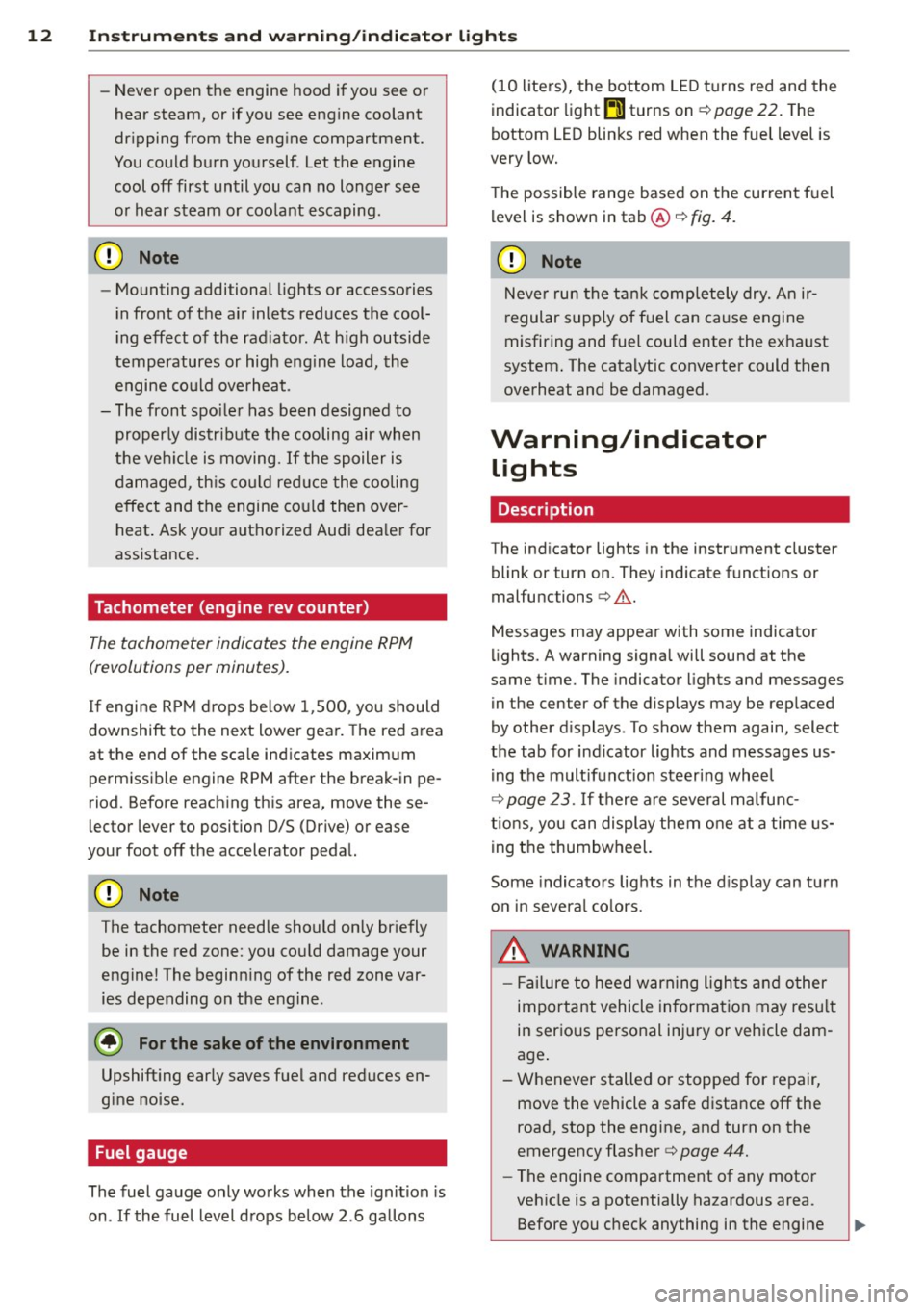
12 Instrum ent s and w arn ing /indic ato r light s
-Never open the engine hood if you see or
hear steam, or if you see engine coolant
dripping from the engine compartment.
You could burn yourself . Let the engine
cool off first until you can no longer see
o r hear steam or coo lant escaping.
@ Note
- Mounting additional lights or accessories
i n front of the a ir inlets reduces the cool
i ng effect of the rad iator . At h igh outside
temperatures or high eng ine load, the
engine could overheat.
- The front spo iler has been designed to
proper ly distribute the cooling air when
t h e ve hicle is moving.
If the spoiler is
dam aged, th is co uld red uce the cooling
effect and the engine co uld then over
heat . Ask your authorized Audi dea ler for
assistance .
Tachometer (engine rev counter)
The tachometer indicates the engine RPM
(revolutions per minutes).
If engine RP M drops be low 1,500, yo u should
downshift to the next lower gear. The red a rea
at the end of the sca le indicates maximum
perm iss ib le engine RPM after the break-in pe
riod. Before reaching this area, move these
lector lever to position D/S (Drive) or ease
your foot off the accelerator pedal.
(D Note
The tachometer needle should on ly br iefly
be in the red zone: you could damage your
engine! The beginn ing of the red zone var
ies depending on the engine .
@ For the sake of the environment
Upshifting early saves fuel and reduces en
gine noise.
Fuel gauge
The fuel gauge only works when the ignition is
on .
If the fuel level d rops below 2 . 6 ga llons (10 liters), the bottom LED turns red and the
indicator light
Em turns on
¢ page 22. The
bottom LED blinks red when the fuel level is
very low.
T he possible range based on the current fuel
level is shown in tab@<=>
fig. 4.
(D Note
Never run the tank completely dry. An ir
r egular supply of f uel can cause engine
misfiring and fuel could enter the ex haust
system . The catalytic converter could then
overheat and be damaged.
Warning/indicator lights
Description
The ind icator lights in the instrument cluster
blink or turn on. They indicate funct ions or
malfunc tions <=>,& .
Messages may appear with some indicato r
lights. A warning signal will sound at the
same t ime. The indicator lights and messages
in the center of the displays may be rep laced
by other d isplays . To show them again, select
the tab for ind icator lights and messages us
i ng the multifunction steering wheel
Q page 23. If t here are several malfunc
t ions, you can display them one at a time us
ing the thumbwheel.
Some indicato rs lights in the d isplay can tu rn
o n in severa l co lors.
A WARNING
- F ailure to heed w arning l igh ts and other
important vehicle in forma tion may res ult
in ser io us personal inj ury or vehicle dam
age .
- Whenever stalled or stopped for repair, move the vehicle a safe d istance off the
road, stop the engine, and turn on the
emergency flasher<=>
page 44.
-The engine compartment of any motor
veh icle is a potentially hazardous area.
Before you chec k anything in the engine
Page 23 of 310
![AUDI S7 2013 Owners Manual Instrument s and warnin g/indic ator ligh ts 21
(0 ) Worn brake pads
rl] Brak e pad s!
If the warn ing light illum inates, immediately
contact your authorized Audi dealer or quali
fie AUDI S7 2013 Owners Manual Instrument s and warnin g/indic ator ligh ts 21
(0 ) Worn brake pads
rl] Brak e pad s!
If the warn ing light illum inates, immediately
contact your authorized Audi dealer or quali
fie](/img/6/57603/w960_57603-22.png)
Instrument s and warnin g/indic ator ligh ts 21
(0 ) Worn brake pads
rl] Brak e pad s!
If the warn ing light illum inates, immediately
contact your authorized Audi dealer or quali
fied workshop to have all brake pads inspect
ed. On USA models the wa rning light
rl]
comes on togethe r with the warn ing light
.. . Both sets of b rake pads on an axle
must always be replaced at the same time .
~ WARNING
Driving with bad brakes can cause a coll i
sion and serious personal injury.
- If the warning light rl] and the wa rning
light ..
1> with the message Bra ke
pads !
comes on in the instrument cluster
display, immediately contact your au
thorized Aud i dea ler or qualified work
shop to have all brake pads checked or
replaced if necessary .
EPC Electronic power control
This warning/indicator light monitors the
electronic power control .
The Im warning/ indicator light (Electron ic
Power Control) illuminates when you switch
the ignition on as a function check .
(!) Tips
If this wa rning/indicator light ill uminates
while you are dr iving, then there is a mal
function in the engine electron ics . Have
the malfunction co rrected as soon as pos
sible by you r autho rized Aud i dea le r or
qua lified repair fa cility.
o Malfunction Indicator Lamp (MIL)
The Malfunc tion Ind icator Lamp (M IL) is par t
of the On -Boa rd Diagnostic (OB D II) system.
The symbol ¢• tights up when the ignition is
switched on and w ill tur n off after the engine
has started and has sett led at a constant id le
1 ) - : USA mod els on ly
-
speed. This indicates that the M IL is work ing
properly .
T he wa rni ng lig ht ill uminates w hen the re is a
malfu nction in t he engine electron ic system .
Contact your a uth orized Audi dea ler and have
the malfunction corrected .
An imprope rly closed fuel fille r cap may a lso
ca use the M IL light to illuminate~
page 2 2 7 .
Fo r more information ~ page 29.
!?) Engine speed limitation
App lies to vehicles: wit h eng ine speed limitat ion
(I! Engine sp ee d maximum XXXX RPM
The eng ine speed is automatically limited to
the speed d isplayed in the driver information
system. Th is protects the engine from over
heating.
The eng ine speed limitation deactivates once
the engine is no longer in the critical tempera
tu re range and you have re leased the accelera
tor pedal once.
If the engine speed limitation was activated
by an engine control malfunction, the indica
tor light
Im a lso tu rns on. Make sure that the
speed does not go above the speed disp layed.
Drive to your authori zed A udi dealer immedi
ate ly to have the ma lfunction corrected.
~. Engine oil level
II Add oil, max. x qt (l). You may continue
dri ving
When the symbol II and driver message ap
pear, add the amount of oil appearing in the
display at the next opportunity ~
page 235.
~tt• Engine oil sensor
Ill Oil level! Sensor defective
If the symbol illumina tes, contact yo ur au
thorized Audi dea ler and have the oil sensor
inspected. Until yo u have this done, check the .,..
Page 32 of 310

30 Instruments and warning/indicator lights
the engine starts and the idle has stabilized.
This indicates that the MIL is working proper
ly.
If the light does not go out after the engine
i s started, or illuminates whi le you are driv
ing, a ma lfunction may exist in the engine sys
tem .
If the light illuminates, the catalytic con
verter could be damaged.
Continue driving
with reduced power (avoid
ing susta ined high speeds and/or rapid accel
erat ions) and have the condition corrected.
Contact your authori zed Audi dealer .
If the light illuminates, the electronic speed
limiter may also be ma lfunctioning. For more
information
Q page 30, Electronic speed
limiter.
An improperly closed fuel filler cap may also
cause the MIL light to illuminate
Qpage227.
On-Board Diagnostics
Fig . 16 Locat io n of Data Link Co nnector (D LC)
On-Board Diagnostics monitors the compo
nents o f your emission control system. Each
monitored component in your engine system
has been assigned a code. In case of a mal
function, the component will be identified
and the fault stored as a code in the control module memory.
The MIL light may a lso illuminate if there is a
leak in the on-board fue l vapor recovery sys
tem. If the light illuminates after a refuelling,
stop the veh icle and make sure the fuel filler
cap is properly closed
Q page 22 7. In order to make an accurate diagnosis, the
stored data can on
ly be displayed using spe
c ial diagnostic equipment (generic scan tool
for OBD).
In order to connect the special diagnostic
equipment, push the plug into the Data Link
Connector (D LC). The DLC is located to the
right of the hood release~
fig. 16.
Your authorized Audi dea ler or a qualified
service station can interpret the code and per
form the necessary repair.
A WARNING
-Do not use the diagnostic connector for
personal use. Incorrect usage can cause
malfunctions, which can increase the risk
of a collision!
Electronic speed limiter
-
Your vehicle may be factory equipped w ith
t ir es that are rated for a maximum speed of
130 mph (210 km/h). This is less than the
maximum speed of your vehicle. To reduce the
risk of sudden tire fai lure and loss of control if
the vehicle is operated at excessive speeds,
your vehicle also has an e lectronic speed limit
er . The electronic speed limiter prevents your
vehicle from going faster than the tire speed
rating . For more information
Q page 257.
If the engine control unit receives faulty vehi
cle road speed signals, the Malfunction Indi
cator Lamp (MIL)
¢fj will illuminate . If this
occurs, contact the nearest authorized Audi
dealer for assistance.
S models
Your vehicle's top speed is electronica lly limit
ed to 155 mph (250 km/h).
If the engine control unit receives faulty vehi
cle roadspeed signals, the Malfunction Indica
tor Lamp (MIU¢.§ will illuminate . If this oc
curs, contact the nearest authorized Audi
dealer for assistance.
Page 228 of 310
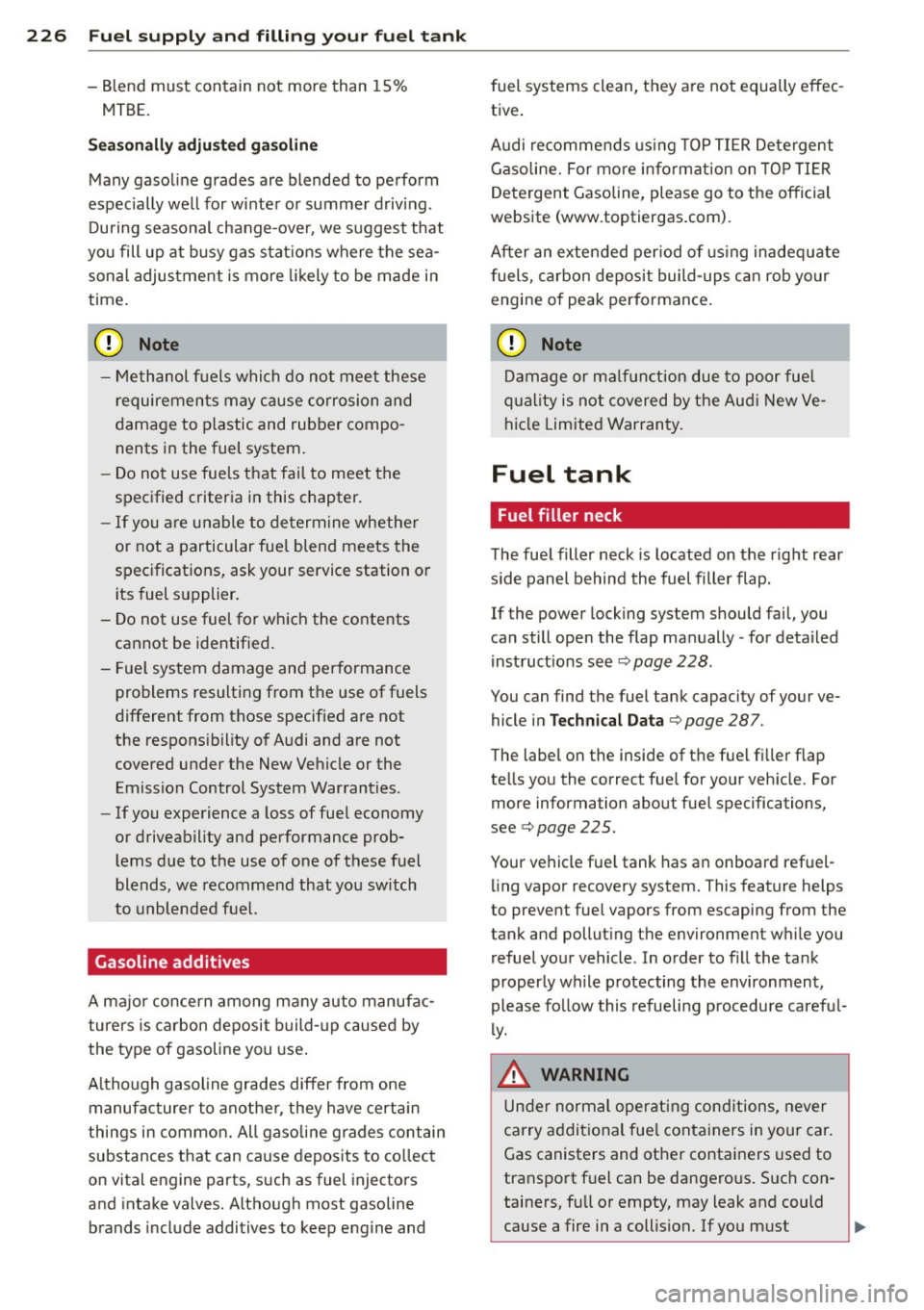
226 Fuel supply and filling your fuel tank
-Blend must contain not more than 15%
MTBE.
Seasonally adjusted gasoline
Many gasoline grades are blended to perform
espec ially we ll for winter or summer driv ing.
During seasonal change-over, we suggest that
you fill up at busy gas stat ions where the sea
sonal adjustment is more likely to be made in
time.
(CT) Note
- Methanol fuels which do not meet these
requirements may cause corrosion and
damage to plastic and rubber compo
nents in the fuel system .
- Do not use fuels that fai l to meet the
specified criteria in this chapter.
- If yo u are unable to determine whether
or not a particular fuel blend meets the
specifications, ask your service station or
its fuel sup plier.
- Do not use fuel for which the contents cannot be identified.
- Fuel system damage and performance
problems resulting from the use of fuels
different from those specified are not
the respons ibility of Audi and are not
covered under the New Vehicle or the Emission Control System Warranties.
- If you experience a loss of fuel economy
or driveability and performance prob l ems due to the use of one of these fuel
blends, we recommend that you switch
to unblended fuel.
Gasoline additives
A major concern among many auto manufac
turers is carbon deposit build- up caused by
the type of gasoline you use.
A lthough gasoline grades differ from one
manufacturer to another, they have certain
things in common. All gasoline g rades contain
substances that can cause deposits to co llect
on vital engine parts, such as fuel injectors
and intake valves. Although most gasoline
brands include additives to keep engine and fuel
systems clean, they a re not equally effec
tive .
A udi recommends using TOP TIER Detergent
Gasoline. For more information on TOP TIER
Detergent Gasoline, please go to the official
website (www.toptiergas.com).
After an extended period of using inadequate
f uels, carbon deposit build-ups can rob yo ur
engine of peak performance.
(D Note
'
Damage or malf u nct ion due to poor fuel
quality is not covered by the Aud i New Ve
hicle Limited Warranty.
Fuel tank
Fuel filler neck
The fuel filler neck is located on the right rear
s ide panel behind the fuel filler flap.
If the power locking system should fail, you
can still open the flap manually- for detailed
instructions see¢
page 228 .
You can find the fuel tank capacity of your ve
hicle in
Technical Data ¢ page 287.
The label on the inside of the fuel fi ller flap
tells you the correct fue l for your veh icle. For
more information about fuel specifications,
see ¢
page 225.
Your vehicle fuel tank has an on board refuel
li ng vapor recovery system. This feature helps
to prevent fuel vapors from escaping from the
tank and polluting the environment while you refuel your vehicle . In order to fill the tank
properly wh ile protecting the environment,
please fo llow this refueling procedure careful
ly.
.8, WARNING
Under normal operating cond itions, never
carry additional fuel containers in your car.
Gas canisters and other containers used to
transport fuel can be dangerous. Such con
tainers, full or empty, may leak and could
cause a fire in a collision. If you must
Page 229 of 310
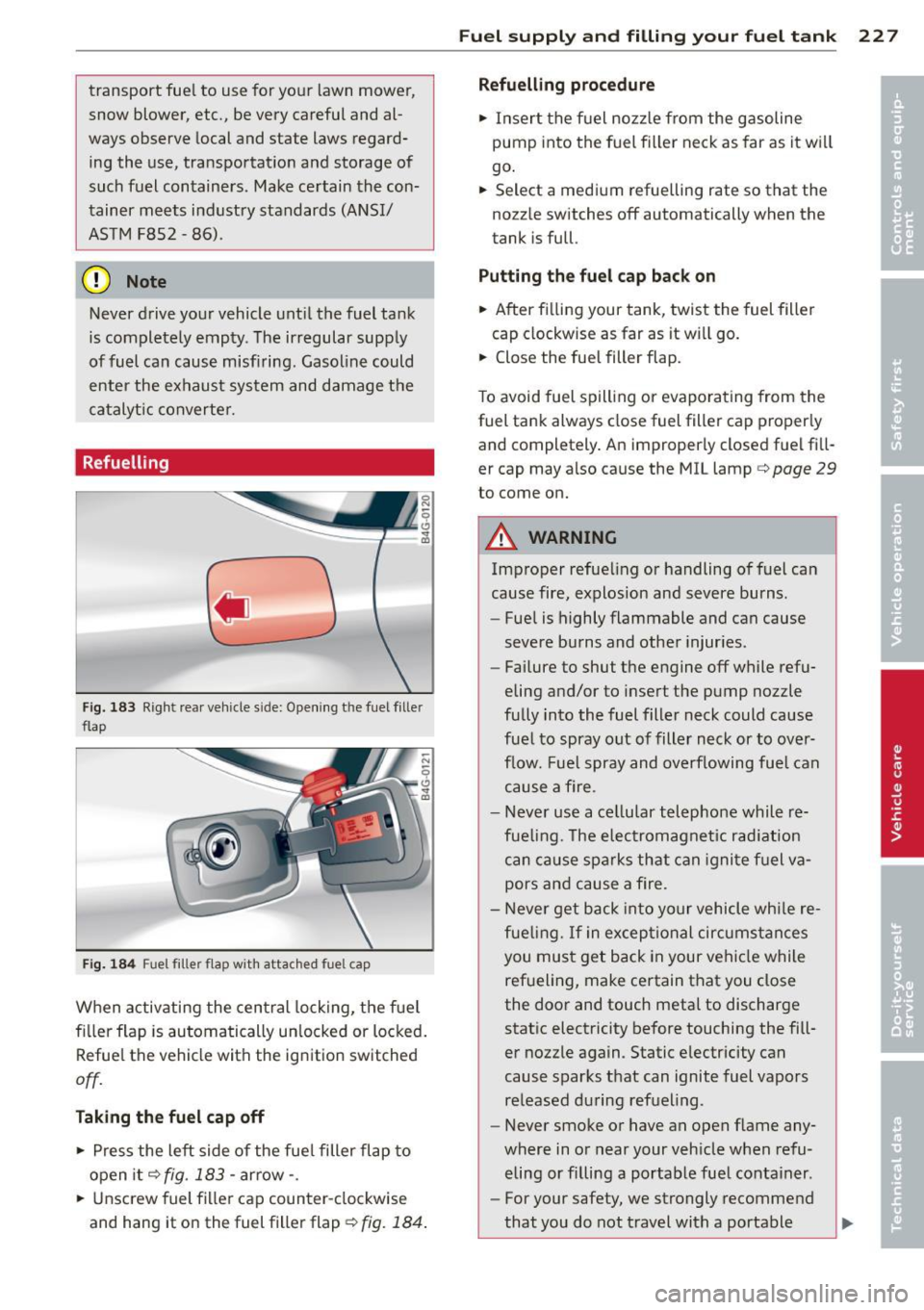
transport fuel to use for your lawn mower,
snow blower, etc., be very careful and al
ways observe local and state laws regard
ing the use, transportation and storage of
such fuel containers. Make certain the con
tainer meets industry standards (ANSI/
ASTM F8S2 -86) .
@ Note
Never drive your vehicle until the fuel tank
is completely empty. The irregular supply
of fuel can cause misfiring. Gasoline could
enter the exhaust system and damage the
catalyt ic converter.
Refuelling
Fig. 183 Right rear vehicle s ide: Opening the fuel filler
flap
Fig. 184 Fuel filler flap with attached fuel cap
When activating the central locking, the fuel
f ill er flap is automatically un locked or locked.
Refuel the vehicle with the ignition switched
off.
Taking the fuel cap off
• Press the left side of the fuel filler flap to
open it¢
fig. 183 -arrow-.
• Unscrew fuel filler cap counter-clockwise
and hang it on the fuel filler flap~
fig. 184.
Fuel supply and filling your fuel tank 22 7
Refuelling procedure
• Insert the fuel nozzle from the gasoline
pump into the fuel filler neck as far as it will
go.
• Select a medium refuelling rate so that the
nozzle switches off automatically when the
tank is full.
Putting the fuel cap back on
• After filling your tank, twist the fuel filler
cap clockwise as far as it will go.
• Close the fuel filler flap.
To avoid fuel spill ing or evaporating from the
fuel tank always close fuel filler cap proper ly
and completely. An improperly closed fuel fill
er cap may also cause the MIL lamp ¢
page 29
to come on.
A WARNING
Improper refueling or handling of fuel can
cause fire, explosion and severe burns.
- Fuel is highly flammable and can cause
severe burns and other injuries.
- Failure to shut the engine off while refu
eling and/or to insert the pump nozzle
fully into the fuel filler neck could cause
fue l to spray out of filler neck or to over
flow. Fuel spray and overflowing fuel can
cause a fire.
- Never use a cellular telephone while re
fue ling. The electromagnet ic rad iation
can cause sparks that can ignite fuel va
pors and cause a fire.
- Never get back into your vehicle while re
fueling.
If in exceptional circumstances
you must get back in your vehicle while
refueling, make certain that you close
the door and touch metal to discharge static electricity before touching the fill
er nozzle again. Static electricity can
cause sparks that can ignite fuel vapors
released during refueling.
- Never smoke or have an open flame any
where in or near your vehicle when refu
eling or filling a portable fue l container.
- For your safety, we strongly recommend
that you do not travel with a portable
Page 230 of 310
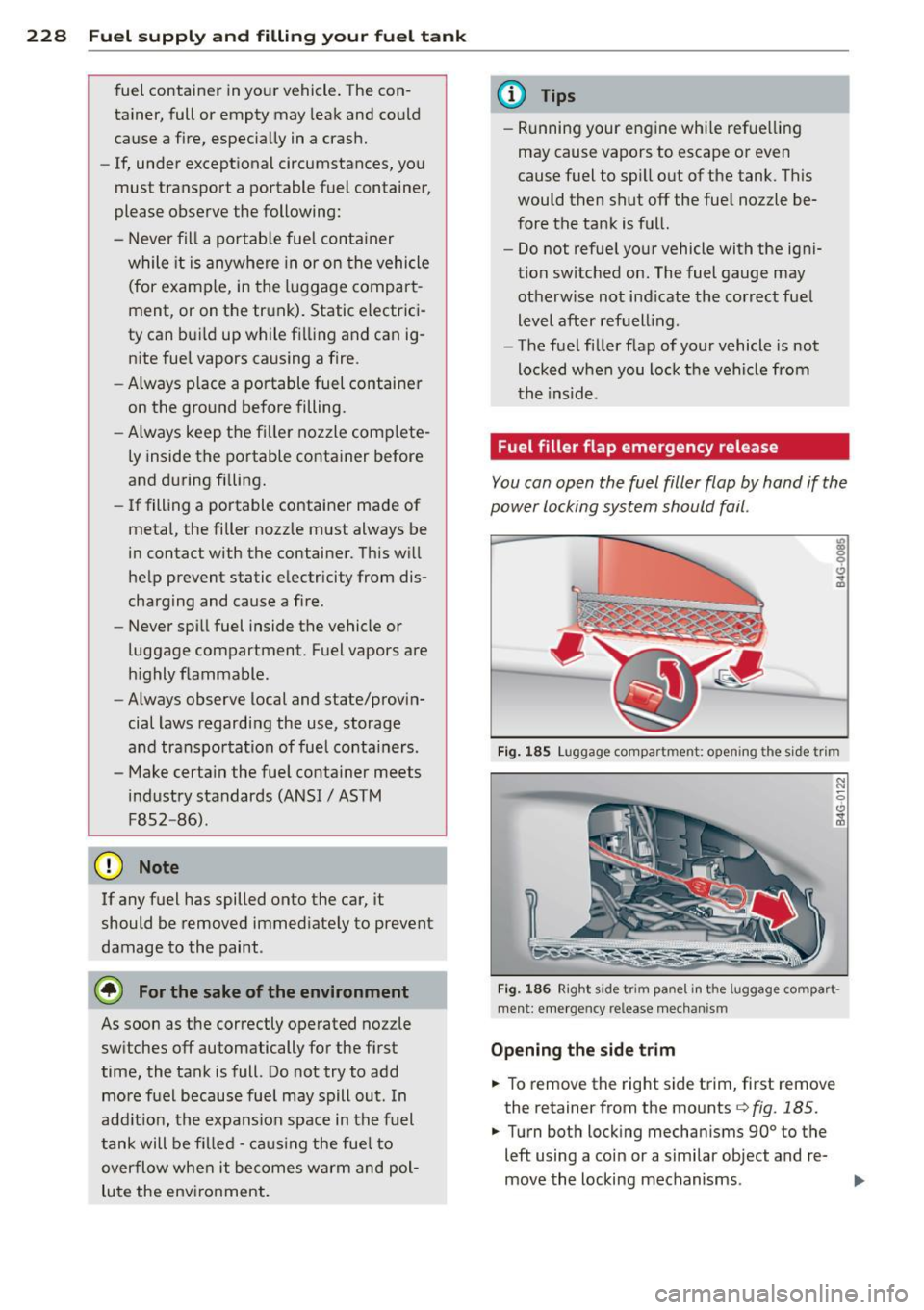
228 Fuel supply and filling your fuel tank
fuel container in your vehicle. The con
tainer, full or empty may leak and could
cause a fire, especially in a crash.
- If, under exceptional circumstances, you
must transport a portable fuel container,
please observe the following:
- Never fill a portable fuel container
while it is anywhere in or on the vehicle
(for example, in the luggage compart
ment, or on the trunk). Static electrici
ty can bui ld up while filling and can ig
nite fuel vapors causing a fire .
- Always place a portable fuel container
on the ground before filling.
- Always keep the filler nozzle complete
ly inside the portable container before
and during filling.
- If filling a portable container made of
metal, the filler nozz le must always be
in contact with the container. This will
help prevent static electricity from dis
charging and cause a fire .
- Never spill fuel inside the vehicle or
luggage compartment. Fuel vapors are
highly flammable.
- Always observe local and state/provin
cial laws regarding the use, storage
and transportation of fuel conta iners .
- Make certain the fuel container meets
industry standards (ANSI/ ASTM
F8S2 -86) .
d) Note
If any fuel has spilled onto the car, it
should be removed immediately to prevent
damage to the paint.
@ For the sake of the environment
As soon as the correctly operated noz zle
switches off automatically for the first
time, the tank is full. Do not try to add
more fuel because fuel may spill out. In
addition, the expansion space in the fuel
tank will be filled -causing the fuel to
overflow when it becomes warm and pol
lute the environment.
(D Tips
-Running your engine whi le refue lling
may cause vapors to escape or even
cause fuel to spi ll out of the tank. This
would then shut off the fuel nozzle be
fore the tank is full.
- Do not refuel your vehicle with the igni
tion switched on. The fuel gauge may otherwise not ind icate the correct fuel
level after refuelling .
- The fuel filler flap of your vehicle is not
locked when you lock the vehicle from
the ins ide .
Fuel filler flap emergency release
You can open the fuel filler flap by hand if the
power locking system should fail.
Fig. 185 Lug g ag e compar tmen t: o pe ning th e side tri m
N
N
0 <.:)
iii
Fig. 186 Rig ht s ide t rim p an el in t he luggage compart
ment : emer gen cy re lease mech anism
Opening the side trim
.. To r emove th e right side trim, first remove
the retainer from the mounts
¢ fig . 185.
.. Turn both locking mechanisms 90° to the
left using a coin or a similar object and re-
move the locking mechanisms. ..,_
Page 232 of 310
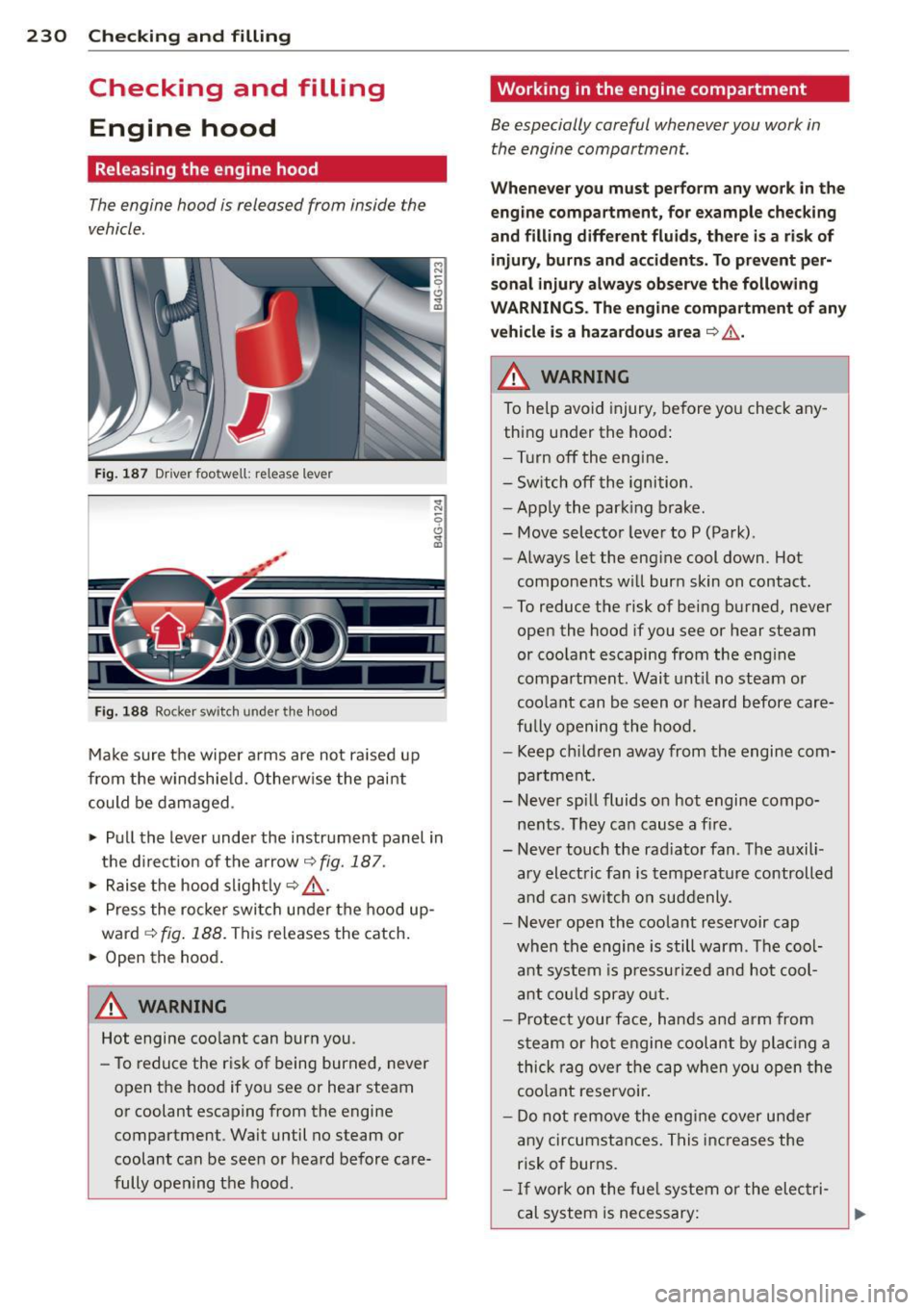
230 Checking and filling
Checking and filling Engine hood
Releasing the engine hood
The engine hood is released from inside the
vehicle .
Fig. 187 Driver foo twell: release lever
Fig. 188 Rocker switch un der the hood
Make sure the wiper arms are not raised up
from the windshield. Otherwise the paint
could be damaged .
.,. Pull the lever under the instrument panel in
the direction of the arrow
~ fig. 187.
.,. Raise the hood slightly~,&. .
... Press the rocker switch under the hood up
ward
~ fig. 188. This releases th e catch.
... Open the hood.
&_ WARNING
Hot engine coolant can burn you.
- To reduce the risk of being burned, never
open the hood if you see or hear steam
or coolant escaping from the engine compartment . Wait until no steam or
coolant can be seen or heard before care
fully opening the hood .
'Working in the engine compartment
Be especially careful whenever you work in
the engine compartment.
Whenever you must perform any work in the
engine compartment, for example checking
and filling different fluids, there is a risk of injury, burns and accidents. To prevent per
sonal injury always observe the following
WARNINGS. The engine compartment of any
vehicle is a hazardous area
~ ,&. .
A WARNING
To help avoid injury, before you check any
thing under the hood:
- Turn off the engine.
- Switch off the ignition .
- Apply the parking brake.
- Move selector lever to P (Park).
- Always let the engine cool down. Hot
components will burn skin on contact.
- To reduce the risk of being burned, never
open the hood if you see or hear steam
or coolant escaping from the engine
compartment. Wait until no steam or
coolant can be seen or heard before care
fully opening the hood.
- Keep children away from the engine com
partment.
- Never spill fluids on hot engine compo
nents . They can cause a fire .
- Never touch the radiator fan. The auxili
ary electric fan is temperature controlled
and can switch on suddenly .
- Never open the coolant reservoir cap
when the engine is still warm . The cool
ant system is pressurized and hot cool
ant could spray out.
- Protect your face, hands and arm from
steam or hot engine coolant by placing a
thick rag over the cap when you open the
coolant reservoir.
- Do not remove the engine cover under
any circumstances. This increases the
risk of burns.
- If work on the fuel system or the electri
cal system is necessary:
Page 249 of 310
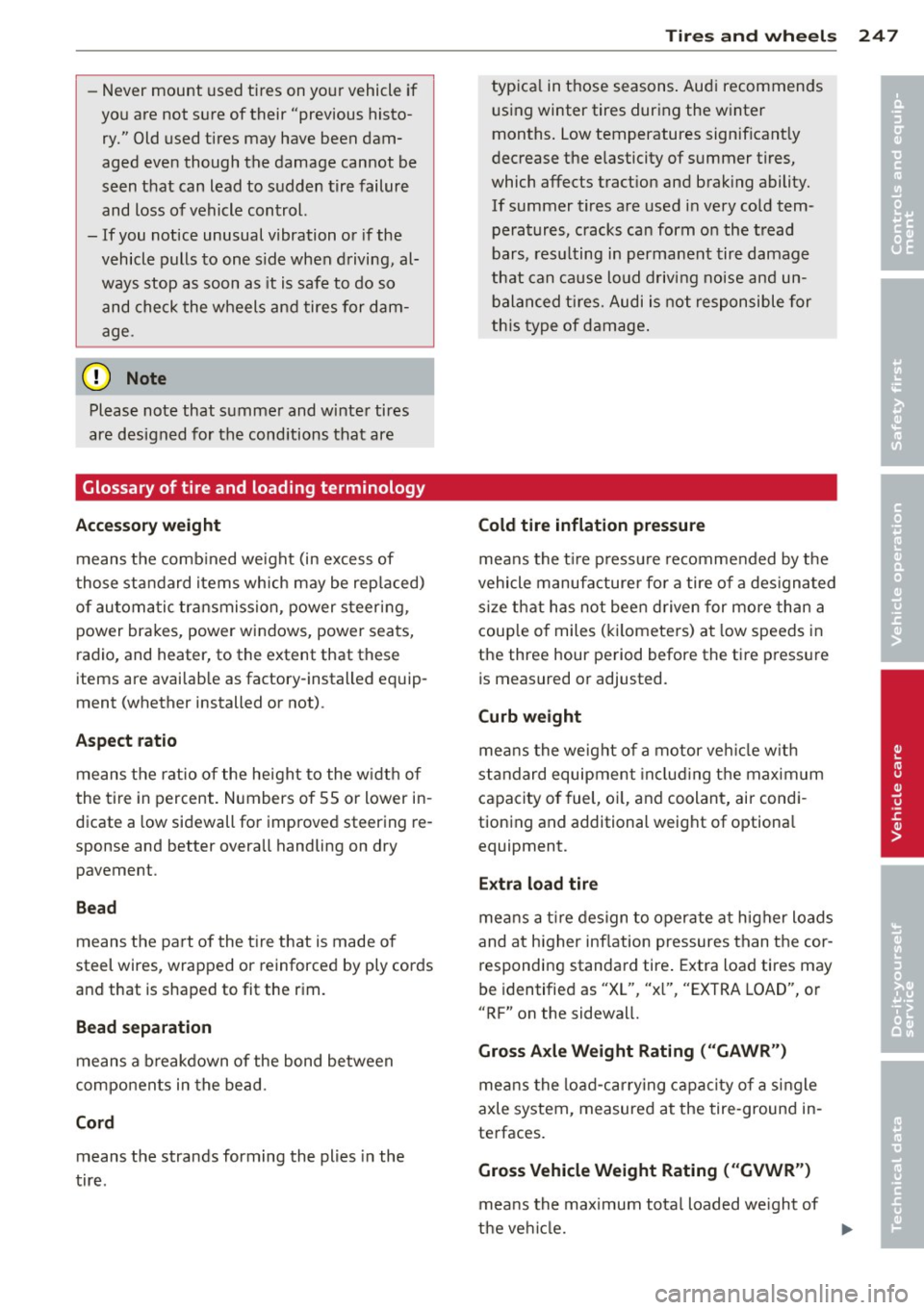
-Never mount used tires on yo ur vehicle if
yo u are not sure of their "previous histo
ry." Old used tires may have been dam
aged even though the damage cannot be
seen that can lead to sudden tire failure
and loss of vehicle control.
- If you notice unusual vibration or if the
vehicle pulls to one side when d riving, al
ways stop as soon as it is safe to do so
and check the wheels and tires for dam
age .
(D Note
Please note that summe r and wi nte r tires
are designed for the cond itions that are
Glossary of tire and loading terminology
Accessory weight means the comb ined weight (in excess of
those sta ndard items which may be rep laced)
of au toma tic transmission, power steer ing ,
power brakes, power windows, power seats,
radio, and heater, to the extent that these
items are availab le as factory-installed equip
ment (whether installed or not) .
Aspect ratio
means the rat io o f the height to the w idth of
the tire in percent . Numbers of 55 or lower in
dicate a low sidewall for improved steering re
sponse and better overa ll handling on dry
pavement .
Bead
means the part of the t ire t hat is made o f
steel wires, wrapped or reinforced by ply cords
and that is shaped to fit the r im.
Bead separation
means a b reakdown of the bond between
components in the bead .
Cord means the strands forming the plies in the
tire.
Tire s an d wheel s 24 7
typica l in those seasons . Aud i recommends
using winter tires during the winter
months . Low temperatures signif icant ly
dec rease the e lasticity of summer t ires,
which affects tract ion and brak ing ability.
If summer t ires are used i n very co ld tem
peratures, cracks ca n form o n the tread
bars , res ulting in perma nen t tire damage
that can cause loud driving noise and un
bala nced ti re s. Audi i s not respon sible for
th is type of damage .
Cold tire inflation pressure
means the t ire p ress ure recommended by t he
vehicle manufacture r fo r a tire o f a des ignated
s ize t hat has not bee n driven for more than a
coup le o f miles (k ilometers) at low speeds in
the three hour period before the tire press ure
is m easured or adjusted.
Curb weight
me ans the we ight of a motor ve hicle with
st andard equipmen t incl ud ing the max imum
capacity of fuel, oi l, and coolant, air condi
tioning and additional weig ht of optiona l
equipment.
Extra load tire
means a t ire design to oper ate a t higher load s
and at higher inflation pressures than the cor
responding standa rd tire . Extra load tires may
be identified as "XL", "x l", "EXTRA LOAD", o r
"RF" on the sidewal l.
Gross Axle Weight Rating ("GAWR")
me ans the load-ca rry ing capac ity of a single
axle system , measured at the tire -ground in
te rfaces.
Gross Vehicle Weight Rating ( "GVWR ")
mea ns the maximum total loaded we ight of
the ve hicl e. .,..
•
•
Page 256 of 310
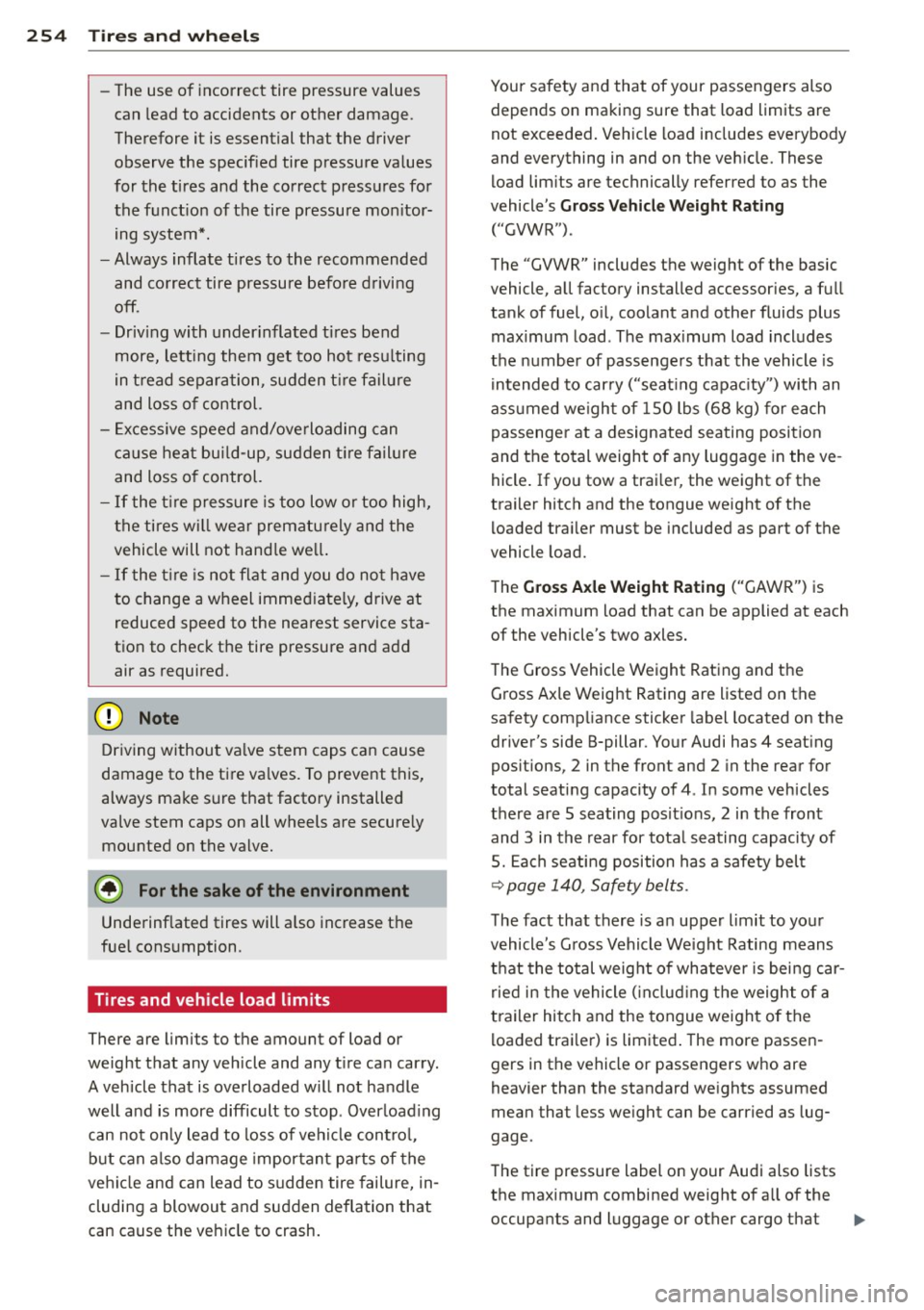
254 Tire s and wheel s
-The use of incorrect tire pressure values
can lead t o acci dents or other damage .
T herefore it is essential that t he driv er
o bserve the specified tire pressure values
for the ti res and the correct pressu res for
the f unct ion of the tire pressure mon itor
ing system*.
- Always inflate tires to the recommended
and co rrect tire pressure befo re d riving
off.
- Driv ing with under inflated ti res bend
more, lett ing them get too hot resu lting
in t read separation, sudden t ire fa il u re
and loss o f control.
- E xcess ive speed and/ove rloading can
c ause heat bui ld-up, sudden t ire fail ure
and loss o f control.
- If the t ire p ress ure is too low or too high,
the tires w ill wear prematu rely and the
vehicle will not hand le we ll.
- If the t ire is no t flat and you do no t have
to change a wheel immed iate ly, drive at
reduced speed to the nearest service sta
t ion to check t he tire pressure and add
air as required.
(D Note
Dr iving w ithou t va lve s tem caps can cause
damage to the tire va lves. To prevent this,
always make sure that facto ry installed
valve stem caps on all wheels are secure ly
mounted on the valve.
@ For the sake of the environment
Unde rinflated tires will a lso increase the
fue l cons umption.
Tires and vehicle load limits
There are limits to the amount of load or
weight that any vehicle and any t ire ca n car ry .
A vehicle that is overloaded w ill not handle
well and is more difficult to stop . Over load ing
can no t on ly lead to loss of veh icle contro l,
b ut can also damage impor tan t par ts of the
vehi cle and can lead to s udden tire failure, in
cluding a blowout and sudden deflation that
can cause the veh icle to crash. Your safety and that of your passengers also
depends on making sure that load limits are
not exceeded . Vehicle load includes everybody
and everything in and on the veh icle. These
load lim its are technically referred to as the
vehicle's
Gro ss Vehicle Weight Rating
("GVWR").
The "GVWR" includes t he weight of the basic
vehicle, a ll factory installed accessories, a full
tank of fuel, o il, coolant and other fluids plus
maximum load. The max imum load incl udes
the number of passengers that the vehicle is
i ntended to car ry ("seat ing capac ity") with an
ass umed we igh t of 150 lbs (68 kg) for e ach
passenge r at a designated seating posi tion
and the total weight of any luggage in the ve
hicle . If you tow a trai ler, the weight of the
trai ler hitch and the tongue weight of the
loaded tra iler must be included as part of the
vehicle load.
The
Gros s Axle Weight R ating ("GAWR") is
the maximum load that can be applied at each of the vehicle's two axles.
The Gross Vehicle Weight Rat ing and the
Gross Ax le Weight Rating are listed on the
safety comp liance sticker label located on the
driver's side B-pillar . Your Audi has 4 seat ing
pos itions, 2 in the front and 2 in the rear for
total seating capacity of 4 . In some vehicles
the re a re 5 seating pos it ions, 2 in the front
and 3 in the rear for tota l seating capacity of
5. Each seat ing position has a safety belt
¢ page 140, Safety belts .
T he fact that there is a n upper limit to yo ur
vehicle's G ross Vehicle Weight Rating means
t h at the total weig ht of whatever is bei ng car
ried in the vehicle ( in cl udi ng the weight of a
trai ler hi tch and the tongue weight of the
l oaded trai le r) is limited . The more passen
gers in the vehicle or passengers who are
heavier than the standard we ights assumed
mean that less we ight can be carried as lug
gage.
T he tire pressure label on your Audi also lists
the maximum combined weight of a ll of the
occupants and luggage or other cargo that .,..
Page 288 of 310
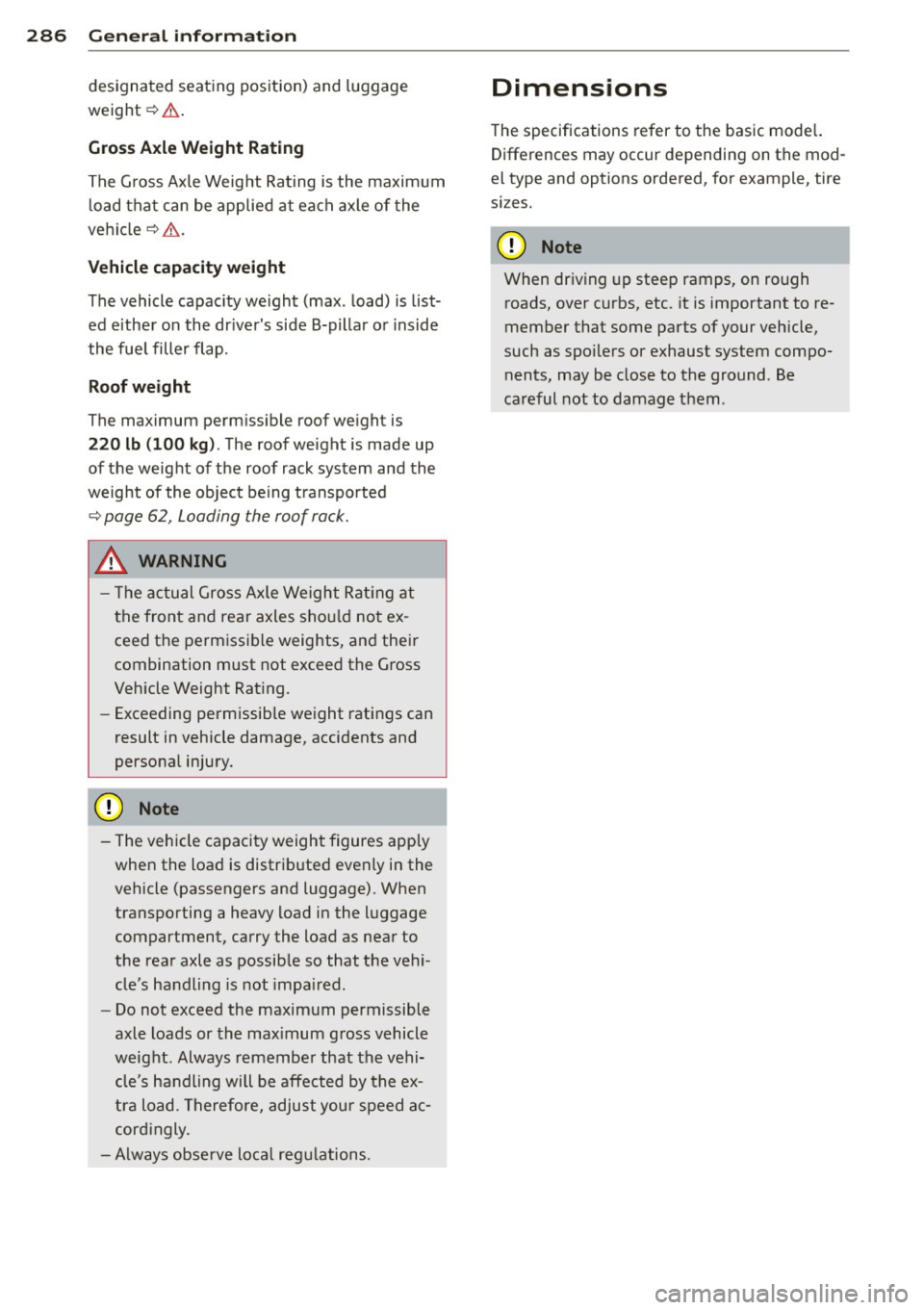
28 6 G enera l inform ation
designated seating position) and luggage
w eight ¢.&, .
Gross Axle W eight Rating
The Gross Axle Weight Rating is the maximum
l oad that can be applied at each axle of the
vehicle ¢Lr!, .
Vehicle capacit y weight
The vehicle capac ity we ight (max . load) is list
ed either on the dr iver's side B-pilla r or inside
the fuel filler flap.
Roof weight
T he m aximum perm iss ible roo f we igh t is
22 0 lb (100 kg ). The roof weight is made up
of the weight of the roof rack system and the
weight of the object be ing transported
¢ page 62 , Loading the roof rack.
A WARNING
- T he ac tual Gross Axle Weight Rat ing at
the front and rear axles shou ld not ex
ceed the permissible weights, and their
combination must not exceed the Gross
Vehicle Weight Rat ing .
- Exceeding permissib le weight ratings can
result in vehicle damage, accidents and
personal injury.
{[) Note
- The vehicle capacity weight figures apply
when the load is distributed evenly in the
vehicle (passengers and luggage) . When
transporting a heavy load in the luggage
compartment, carry the load as near to
the rear axle as possib le so that the vehi
cle 's ha ndling is not impa ired.
- Do not exceed the maximum permissible
axle loads or the max imum gross vehicle
weight . Always remember that the vehi
cle's handling will be affected by the ex
tra load . Therefore, adjust your speed ac
cord ingly.
- Always obse rve lo ca l regu lations.
-
Dimensions
The specifications refer to the basic model.
Diff erences may occur dep ending on th e mod
el type and options o rdered, for example, ti re
si zes.
~ Note
When driving up steep ramps, on rough
roads, over curbs, etc . it is important to re
member that some parts of your vehicle,
such as spo ilers or exhaus t system compo
nents, may be close to the ground . Be
careful not to damage them .